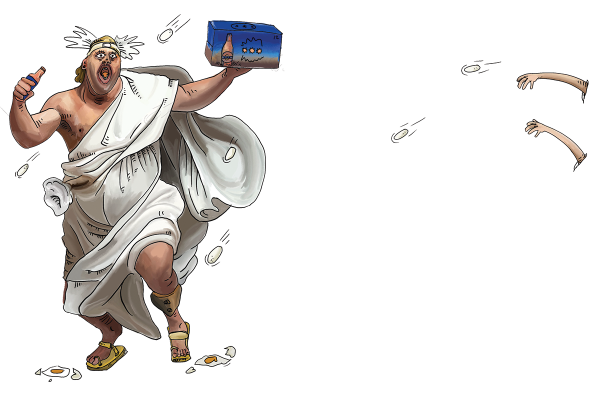Before you get upset about the title, understand that a toga party in New Zealand in 2023 is about as Roman as it is Martian, so making a Greek pun is excusable.
With that out of the way: Toga party. What’s the deal? This annual event has become an intrinsic part of student culture in Dunedin over the past couple of decades, but where did this absurd tradition come from? And how does it relate to the University of Otago? Short answer: There is absolutely no direct link between Rome and Dunedin except for the fact that both have seven hills. Possibly. Jury’s still out on whether Dunedin has seven hills or more, but close enough I guess.
First we had to make sure there wasn’t some obscure Roman connection that we’d missed. To figure this one out, Critic Te Ārohi had a chat with Cameron McPhail, a University of Otago graduate with a PhD in Classical Studies who probably knows something about Rome. Cam told Critic Te Ārohi that Dunedin’s only link to Roman culture is the “neoclassical architectural style, which emerged in the 18th century”, which we believed because they have a degree and we do not.
The Dunedin Railway Station, the First Church of Otago, the Law Courts, and the Olveston Historic Home are all built in the style developed when empire building became a thing again and people started simping over some brand called “SPQR”. Cam’s long-winded yarns aside, Critic Te Ārohi couldn’t help but point out that there's a pretty sizable gap between architecture and the scarfie chaos entangled in the toga tradition. So, why toga?
That’s where Mr Stephen Hall-Jones comes in, who was the activities manager of OUSA from 1986-2003. A stone-cold legend, Mr Jones was responsible for starting the first ever Toga party in 1990. Poked on where the idea came from, Jones reminisced, “[It was] nothing too original. There’s an old John Belushi film called Animal House, which had a University toga party. One or two other universities in NZ also had toga parties, but ours became more of an ingrained tradition.”
Maybe that’s because, as Jones stated, “It had its own particular vibe.” Jones mentioned that the event was predominantly for first year students as it was usually at the start of the week and featured only smaller acts. Sharing his sympathy for the breed, Jones remarked, “You knew that two weeks later they’d be as bitter and cynical as the rest of us, but for that night you kind of realised most would think back with fond memories.”
Mr Jones' story is a touching one, filled with the triumph of a university culture coming into its own. Alas, all of that changed at the turn of millennium when the toga party became irrevocably tarnished. As the years wore on, the event gradually slipped into obscurity before being elevated with a procession through George Street. What a playful take on the graduation procession. Strange it doesn’t happen any more, huh? Yeah, there’s a reason.
It was the toga party of 2009. If you ask anyone what it was like, they’ll probably tell you without hesitation that it scarred them for life. Eggs rained down from the heavens on unsuspecting victims, shop fronts were vandalised and violence was perpetrated unashamedly. In 2010 it got even worse. Students showed up to the event an hour earlier than organisers had planned due to a communication mix-up. With no facilities to quell tensions and a well-timed game of beer-pong, chaos ensued. Unspeakable atrocities were committed that night, none of which Critic Te Ārohi is willing to discuss in good conscience.
Burdened by bad publicity, the toga party went into a subdued hiatus in 2011 before returning better than ever before. The 2012 event was to be hosted at the Forsyth Barr Stadium, a venue which was, at the time, fresh on the scene. Students rejoiced at the prospect of a return to glory and, sure enough, the toga party was quickly back on its feet. The event went on without a hiccup until the start of last year, when the event was postponed until Re-Ori due to Covid protocols. To discuss this year’s event and the future of the tradition, Critic Te Ārohi had a chat with OUSA events team lead Laurence Potter as he slurped down a bowl of noodles.
Between mouthfuls, Laurence told us that this year’s toga party was “anecdotally, and certainly from our perspective, the best it's ever been”. Laurence suggested that the toga party acted as a “rite of passage for the first years who generally buy into it”. Looking to the future he mused that “the toga party is never stagnant. At the end of the day it's about building an experience.” Rest assured, the future of the event is in safe hands with Laurence and the events team.
If the toga party's history was a bedsheet, it would have a few blood stains in the middle and maybe some egg yolk around the edges, but it’s one that any breatha running behind on washing would gladly wear. The reputation of toga is on the mend, allowing for a new generation of freshers to bask in its greatness. While there’s nothing particularly original about the beginnings of the toga tradition, the same can be said for almost any other tradition (looking at you, Christmas). So, next year when you see a fresher guffawing their way down Dundas, don’t scoff. Instead, salute. Remember that you were them, once. It is freshers who carry the fire of tradition, a fire we all huddle around in times of uncertainty.



